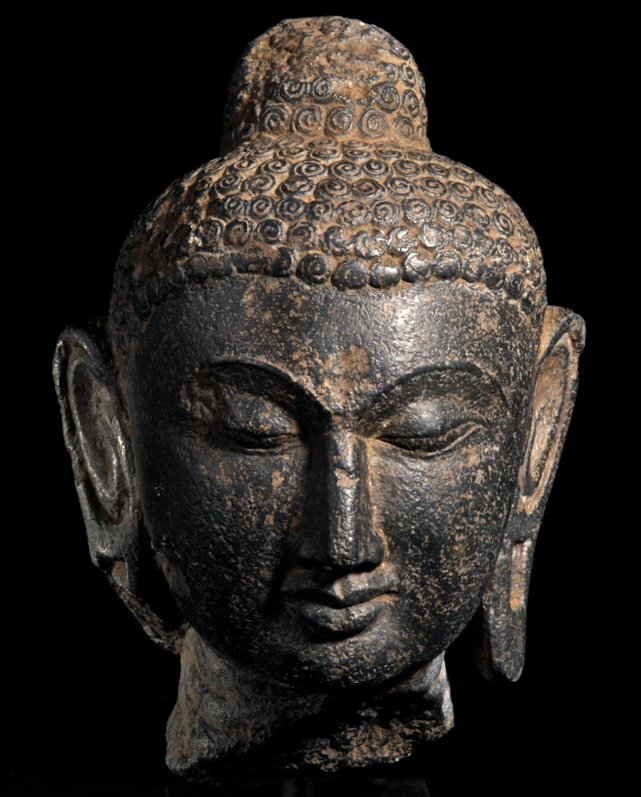

Title: Ancient Asian India Gupta Art Stone Carving Buddha Head
Shipping: $29.00
Artist: N/A
Period: Antiquity
History: N/A
Origin: Central Asia > India
Condition: Museum Quality
Item Date: 300 AD to 600 AD
Item ID: 6394
Gupta Stone Head of Buddha. Origin: India Circa: 300 AD to 600 AD Dimensions: 8" (20.3cm) high Collection: Asian Art Medium: Stone. Condition: Very Fine. This imposing stone head of Buddha dates from what many refer to as the Golden Age of India. At this date, what is now northern India, Bangladesh and parts of Pakistan were ruled by the emperors of the Gupta Empire, whose peaceful and prosperous rule saw a flowering of arts and sciences that ranks alongside the civilisations of the Han and Tang Dynasties and the Roman Empire. The achievements of the Gupta Empire are numerous and impressive. Their stable currency of gold dinars, combined with an effective administrative system, helped to fund major developments in architecture, medicine, art, drama, design, mathematics and literature. The western world learnt much of its expertise in pharmacopoeia, cesarean section, bone setting, and skin grafting from Indian medics of this period. The Indian numeral system – which we use today – was taken by the Arabs to Europe where it replaced the Roman system; seemingly western inventions such as the decimal system, algebra, geometry and astronomy – especially the description of heavenly bodies and their orbits, and the assertion that the earth is round rather than flat – were all either invented or refined in the Gupta period. The empire’s shadowy beginnings are generally agreed to have started with the reign of Sri- Gupta in around 250 AD, whose people may have come from the Bengal area. By the 4th century there were various small Gupta kingdoms scattered around the Magadha area. The early rulers of the Gupta Empire – and their followers – were firm believers in Hinduism, but were tolerant of other religions and permitted the construction of temples and shrines to the Buddhist faith. Interestingly, the Hindu cults of Saivism and Vaisnavism shared many characteristics of Buddhism, to the extent that Buddha was eventually accepted as an alter-ego of Vishnu. Gupta Buddhism was based primarily around the Hinayana and Mahayana sects, with increasing emphasis on the latter towards the end of the Gupta dynasty. The iconography of the movement captured the attention of a large retinue of followers, who were particularly taken with the Mahayana Bodhisattvas, namely Manjusri, Avalokitesvara and the goddess Prajnaparamita. Worship of these images and that of the Adi and Amitanbha Buddhas became increasingly popular, and it this is the source of the current piece. The sculpture represents the head of the Buddha, and was originally attached to the torso as well as to a temple wall or similar. The expression is one of serene contemplation, and is elegant and streamlined compared to the rather obese and disproportionate Chinese Buddhas of later periods. It also contrasts with Buddhas made in the Gandhara tradition, as they tend to be more lifelike, while this is expressionistic in its poise and execution. The face has high, arched brows overhanging half-closed, hooded eyes, running down to a slender and tapered nose and a small, pursed mouth. The flow of the facial features is perfectly captured, including the rise and fall of the facial contours of the cheeks and forehead. The ears are long-lobed, pierced and pendulous, while the head – surmounted by the ushnisha (additional brain of elevated consciousness) – is decorated with tight snail-shell curls. This is a serene and beautifully-executed piece of ancient Gupta art, and a worthy addition to any serious collection of the genre. *All of the art is edited and chosen by us for its high quality and workmanship before posting. These collectibles have been selected with the artist & collector in mind. We are committed to enhancing our customer’s lives by discovering creating, and pointing out only the best art we can find in the world today. We Are Taste-Makers, Art Advisers, Consultants & Publishers Of Spectacular Art Stories. Our job is to be intermediaries between buyers and sellers. We are vetting for high end art patrons. We are determined to catalog the world's most exceptional art and share it with everyone.
Link: http://en.wikipedia.org/wiki/Buddha_Gupta
Budhagupta (Sanskrit) (reigned c. 476–495) was a Gupta emperor. He was the successor of Kumaragupta II and the predecessor of Narasimhagupta Baladitya. He was the son of Purugupta. He had close ties with the rulers of Kannauj kingdom and together they sought to rule the Huns out of the fertile plains of Northern India.
The Damodarpur copper-plate inscription informs us that Pundravardhana bhukti (the present-day North Bengal) was ruled by his two viceroys (Uparika Mahararaja) Brahmadatta and Jayadatta. The Eran stone pillar inscription of two brothers, Matrivishnu and Dhanyavishnu mentions Budhagupta as their emperor (Bhupati), under whom Maharaja Surashmichandra was governing the land between the Yamuna and the Narmada The Buddha image inscription found from Mathura is dated in Budhagupta's reign. It shows that his authority was extended to Mathura in the north.
The royal BudhaGupta inscription on Archaeological site Eran column is on the west face towards the bottom of the lower and square part of a large monolithic red-sandstone column situated near the ruined group of temples at Eran. The inscription refers to the reign of Budhagupta and it is dated A.D. 484-485. The object of it is to record the erection of the column, which is called 'dhvajastambha' or flag staff of the god Vishnu. This Pillar height about 48 fit. First discovered this inscription by T.S. Burt in 1838.